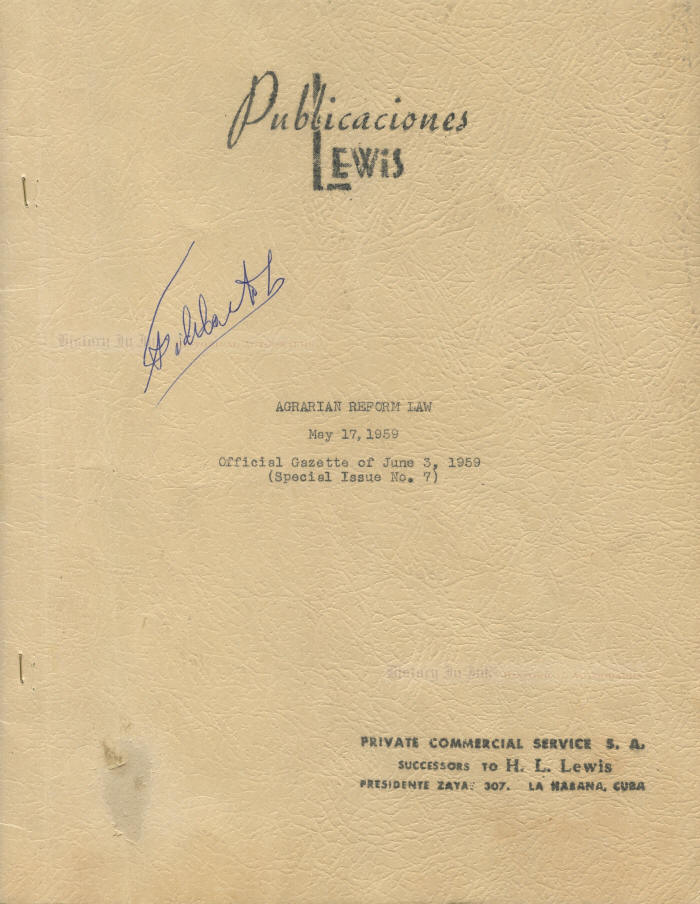1427601
Fidel Castro
Scroll down to see images of the item below the description
Castro signs—in person—a copy of the centerpiece of his revolutionary reforms:
the Cuban Agrarian Reform Law of 1959
Fidel Alejandro Castro Ruz, 1926–2016. Cuban revolutionary leader. Prime Minister of Cuba, 1959–1976; President of Cuba, 1976–2008; First Secretary of the Central Committee of the Communist Party of Cuba, 1961–2011. Superb Document Signed, Fidel Castro, in person, 19 pages, with cover, 8¼” x 11”. With letter and documents of provenance.
This exceptional typescript of the Cuban Agrarian Reform Law represents the centerpiece of Castro”s reforms—the seizure and redistribution of agricultural land—imposed shortly after his rebels overthrew President Fulgencio Batista. The Castro government enacted the law on May 17, 1959, some 4½ months after Batista fled Cuba and conceded control to Castro.
The corrupt and repressive dictator Batista had aligned himself with wealthiest landowners who controlled the largest sugar plantations in Cuba. His government exploited Cuba’s commercial interests by negotiating lucrative deals with American corporations that had heavily invested in Cuba and with elements of organized crime that controlled drug, gambling, and prostitution in Havana. Even the United States furnished the Batista government with financial, military, and logistical support. Under Batistaʼs control, however, Cubaʼs economy stagnated, and the gap between the rich and the poor widened. Batista stifled proletariat protests and student riots through tight media censorship and sheer brutality. His secret police were responsible for torture and killings, including public executions without trials. Several thousand people died at the governmentʼs hands.
Castro’s July 26 Movement, which included Raúl Castro and Che Guevara, and other rebel elements led uprisings against the Batista government. Fighting lasted two years until rebels under Guevara’s command captured the city of Santa Clara. Within 12 hours, Batista fled Cuba, and Castro assumed military and political power. Castro installed politically moderate lawyer Manuel Urritia Lleó as provisional president and assumed the role of prime minister himself the next month.
Agricultural land reform lay at the heart of the revolution. Agriculture was the largest part of the Cuban economy, and large sugar plantation owners controlled much of it. Land reform had its beginning in October 1958, when the rebel army promulgated Law No. 3, the fundamental tenet of which was that those who cultivated the land should own it. In a speech on January 27, 1959, Guevara, discussing “the social ideas of the rebel army,” declared that the new government’s main concern was “the social justice that land redistribution brings about.”
This Agrarian Reform Law, the first of two following Castro’s seizure of power, was thus one of the earliest enactments of the Castro government. It belies Castro’s denials that he was communist and his refusal to characterize his government as socialist. The law, which spans 19 pages in this English translation, permitted state-run land cooperatives but outlawed large land holdings, condemned the lands of large landowners, nationalized land owned by foreign interests, and forbade foreign ownership of sugar cane plantations. It established the National Agrarian Reform Institute, led by Castro himself—and the Institute quickly became the most important governing body in the country.
With certain exceptions, this law provided:
ARTICLE 1. The latifundium is hereby outlawed. The maximum area of land which any physical or corporate person may own shall be 30 “caballerias” (33.16 acres each). All lands owned by any physical or corporate person in excess of such maximum area shall be condemned and distributed to the peasants and farm workers who have no land of their own.
Even “lands owned by the State, the provinces and the municipalities,” the law said in Article 3, “shall also be subject to distribution.”
The law outlawed sharecropping except for sugar cane milling contracts. With respect to sugar cane—Cuba’s principal cash crop—the law provided:
ARTICLE 12. Effective one year following the promulgation of this law the corporations not meeting the following requirements may not operate sugar cane plantations:
a) All their shares must be registered.
b) The holders of such shares must be Cuban citizens.
c) The holders of said shares may not be persons who appear as owners, stockholders or officers of concerns engaged in the production of sugar.
Once said period of time shall have elapsed the lands belonging to corporations not meeting the requirements prescribed by this law may be condemned. Likewise said corporations shall forfeit their right to the milling quotas which they may have at the time of the promulgation of this law.
ARTICLE 13. The natural persons who are owners, stockholders or officers of concerns engaged in the production of sugar may not operate sugar cane plantations. The lands belonging to such persons on which sugar cane plantations are operated may be condemned for the purposes sought by this law.
The law then provided for redistribution of land. Article 16 declared an area of “two (2) caballerias of fertile land, without irrigation and distant from urban centers,” to be the “the ʻvital minimumʼ for a peasant family of five (5) persons, engaged in crops of medium economic yield,” and it charged the National Agrarian Reform Institute with “regulating and deciding in each case what the ʻvital minimumʼ required is, starting from that basis and considering the average annual income level expected for each family.”
This, then, is the law by which Castro implemented the first, and arguably the most important, piece of his revolutionary plan for Cuba.
Castro signed this typescript in person in Havana, Cuba, in September 1959. He signed for an American college student who was there as part of Operación Amistad, or “Operation Friendship,” during which the Castro government hosted 190 American students to show them the effects of the Cuban revolution. The recipient encountered Castro, who was about to speak to the group, by the swimming pool on the top of Havanaʼs largest hotel and asked him to sign this piece, copies of which Castroʼs aides had given the students. To the recipientʼs knowledge, this was the only that Castro signed.
Castro has signed with a bold, blue ballpoint signature on the cover. The cover shows a bit of soiling and a surface abrasion in the blank area at the lower left, affecting nothing. There are mounting traces on the back from prior mounting in an album. Overall it is in fine condition. The piece comes with documents of provenance from the recipient who had Castro sign for him.
This superb item has never been offered on the autograph market before. It belongs in the finest of collections.
Unframed.










